
Every year in January the small Mexican town of Chiapa de Corzo holds a gigantic festival and party. There is a fair, and fireworks, and processions celebrating the town’s patron saints. Fruit is hung from the rafters, men dress as women and women dress as men, and Parachicos and Chiapanecas in extravagantly colourful costumes parade through the streets. It’s a two-week spectacular and we attended for the final eight days.
Days one, two, and three: The Dazzling Rhythms of Tradition
Days four, five, and six: Chasing Chuntas
***********************************
Thirty-five million years ago, with nobody watching, the earth moved, and the crust cracked open. Over the millennia water poured into the crack forming a river deep in the earth. Wind and water created a canyon thirteen kilometres long and up to one thousand metres deep. Today it is known as Sumidero Canyon, and is surrounded on both sides by the wilderness of Sumidero Canyon National Park.
22 January 2017. On the seventh day: Early morning in a boat on the river. Despite having no sleep the muscles unwind and the heart rejoices. The river flows by me and through me and I feel myself relax. It’s a welcome break from the wild confusion of the festival. The water is soothing like a balm.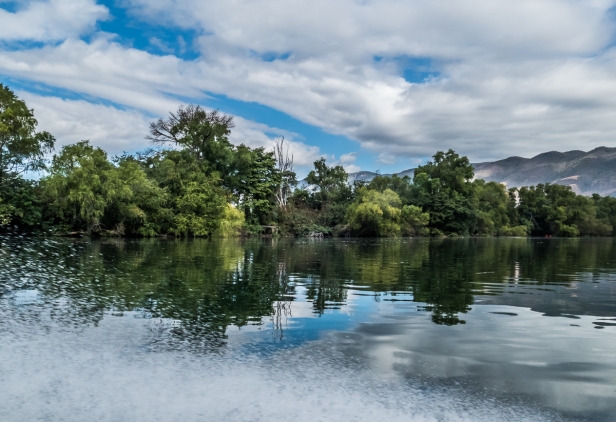
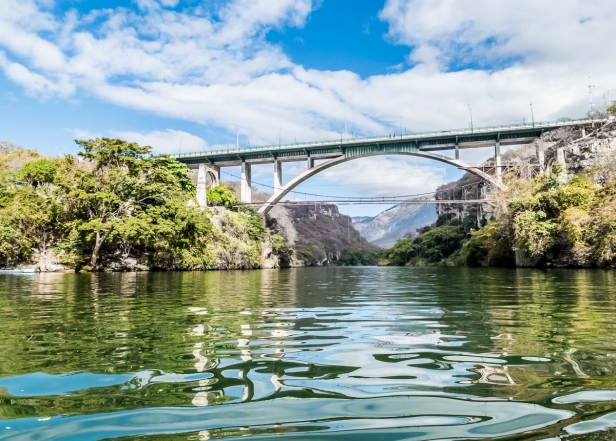
Several dams have been built along the 480 kilometres of the Grijalva River. As a result the Sumidero Canyon became navigable. Our journey takes us through the canyon
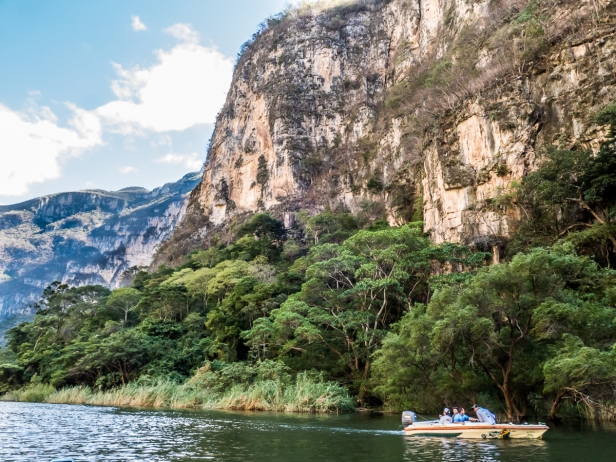
past lazy iguanas sunning themselves in a tangle of branches along the shore,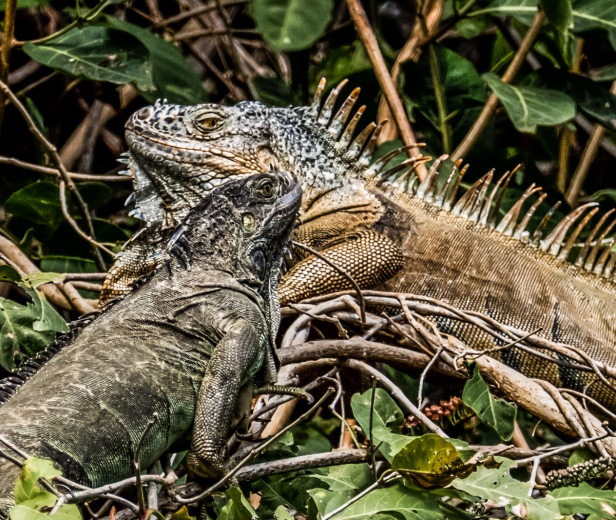
past a large preening committee of vultures on a white stone bank,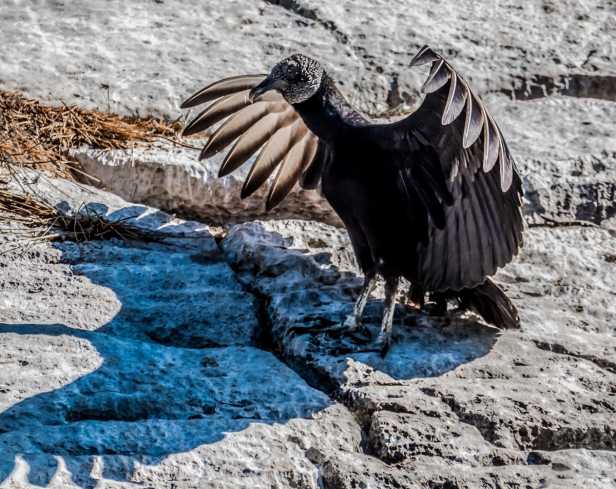
past flying egrets,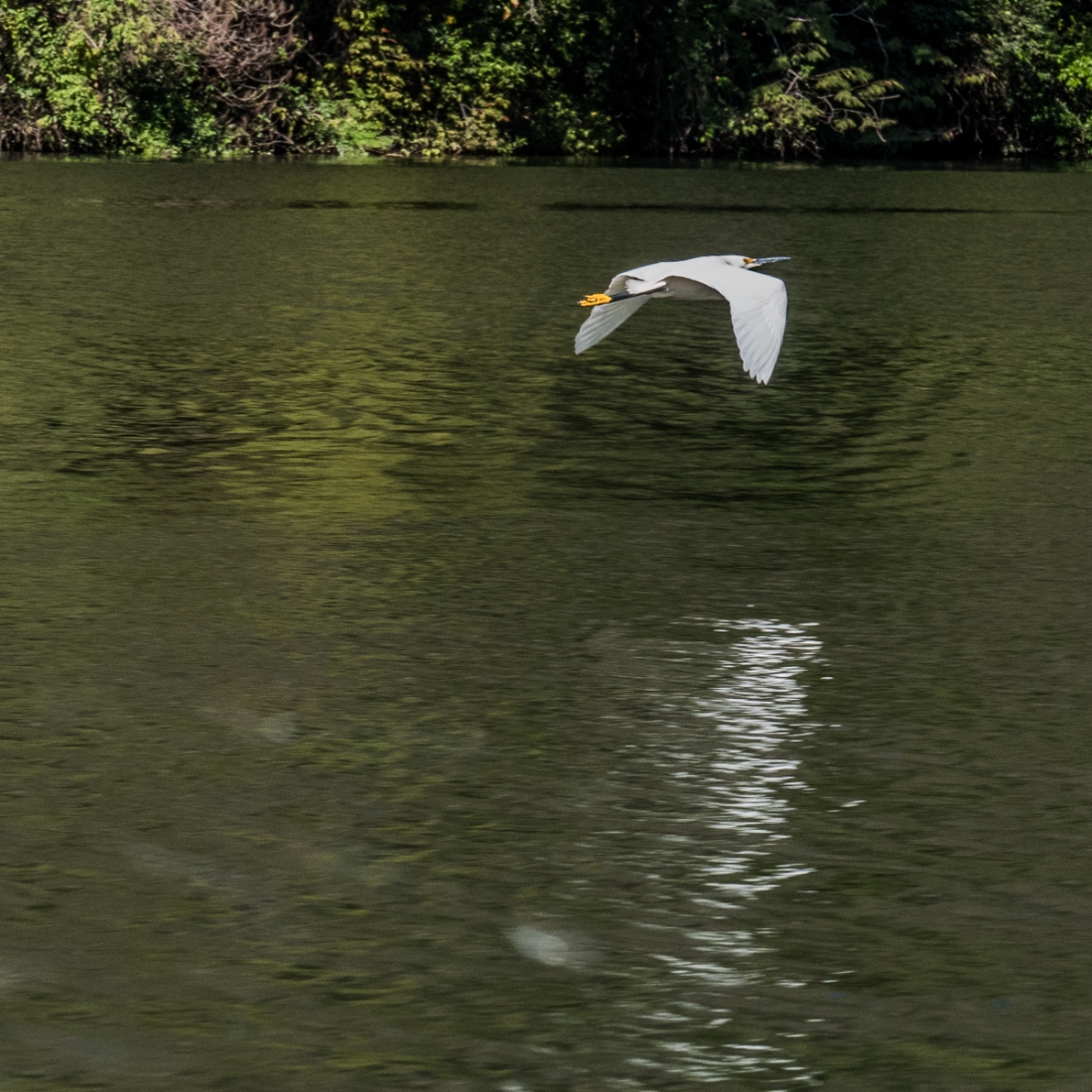
and so to the Christmas Tree.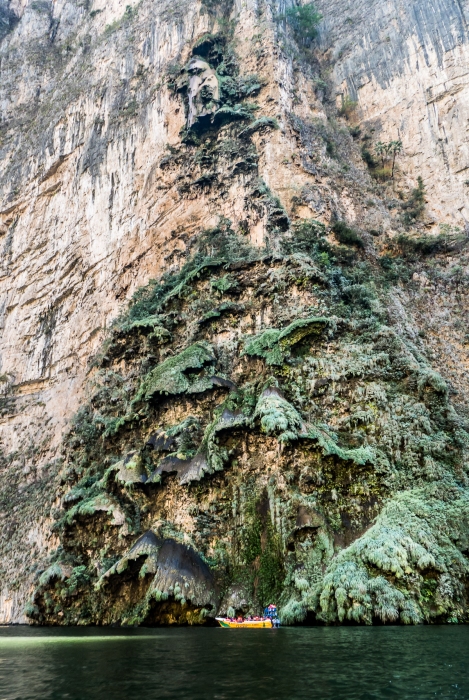
During the wet season the water streams down here bringing with it silt and debris from above. Gradually over the years the debris clung to the cliff-face forming deeper and deeper “shelves”. Seeds arrived on the wind and moss and plants covered the shelves all the way down to the water.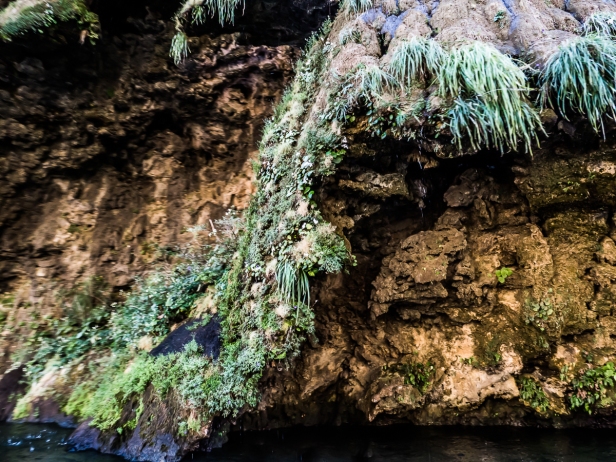
We go all the way to the top of the dam. On the way back
our guide spots a crocodile resting in the mud and tangled branches of the shore, sadly surrounded by seven discarded plastic bottles. We are not in pristine wilderness here and the truth is a little jarring.
***********************************
It moves like a hot glacier. It has the fiery passion of the tropics, the smiling warmth of joy and excitement, and colours hot enough to light up the world, but it is nevertheless a glacier. It forges ahead slowly, powerfully, and imperceptibly, plowing over everything that would stand in its way. The grand procession of the penultimate day of the Fiesta Grande de Enero will not be stopped. Everything and everyone that could hinder it is crushed. Entire families of Chuntas,
Parachicos,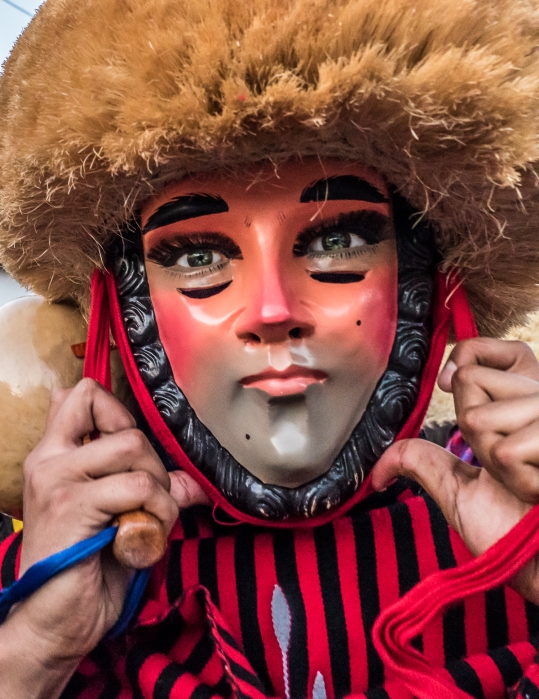

and Chiapanecas
surge relentlessly forward chanting, dancing, shaking their rattles, hollering, and laughing.
We’d been told that the parade would start at two. When we get to the town square we are told 4.30 so we return at that time and still there’s nothing happening. Don and I go our separate ways. I see likely participants – a couple of cross-dressers,
and several chuntas.

The men dressed as women are the traditional Chuntas, though now families dress up together. They represent and honour the servants of a wealthy Spanish woman who helped the village during a famine in the 1700’s. They all seem to be headed in the same direction so I follow them hoping to find the beginning of the parade.
I can see I need to be quicker. I double back and head down a side street. I’m walking way faster than I should be, and know I’ll pay for it later, but I’m so focused on my goal that it doesn’t matter. Down the side street I finally see the parade at the end of the street behind a wall of people. I hear the glacier surging forward, but it is impossible to get to it. Behind me, resting on a stoop is a weary deer and her boyfriend. She is dressed to entice people to take photos of, and with her, for a fee. It’s a day to make some money for those who are creative enough to take advantage of the situation. By this time, though, she is too tired to even react when I photograph her. Beneath all that makeup she has the most astonishing green eyes.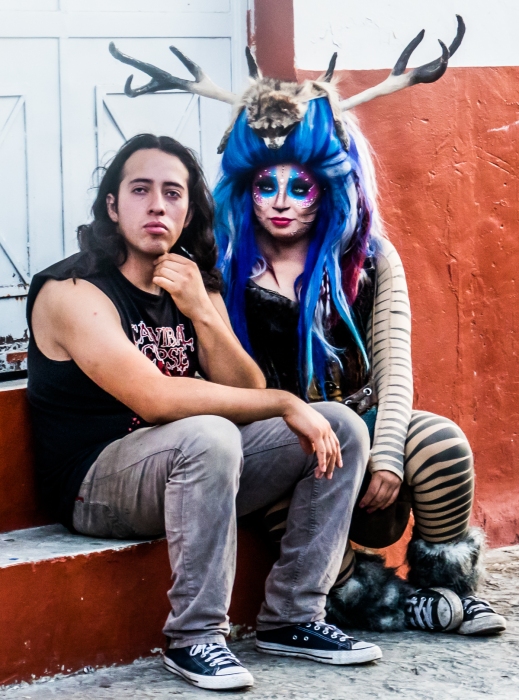
Turning around I decide to head back to the town square where I somehow manage meet up with the glacier as it heaves past me, all bright smiles and wild colours.


I need to move. There is a barricade of people behind me, body to body. I push part way through and can go no further. I’m not afraid, just stuck, with one foot on a step, the other dangling towards the step below, and my camera clutched tightly to my chest. I think it is only the people pressed all around me that keep me upright. I stay this way for a minute or two then realize that I must myself become a glacier and simply plow forward. I escape to the relative sanity of the colonnades on the south side of the town square, and then move to the west side. At this point I decide I’ll simply stay put and wait for the procession to come to me. There’s seating all along one side of the street where people are waiting, and in the middle of the street more people are gathered. Some, like me, have come to see the show; others are participants waiting to join in. There’s music of course. There’s always music. I watch enchanted as a couple of children dance to the beat,
and another, a tiny Chiapaneca, poses for the camera just as she’s been taught.
Across from the seating I find myself a position standing on the curb. There is a wall behind me, and people all around. There is nowhere to move but at least I’m in front and can see whatever is to come. It’s dark now and the hot glacier finally arrives.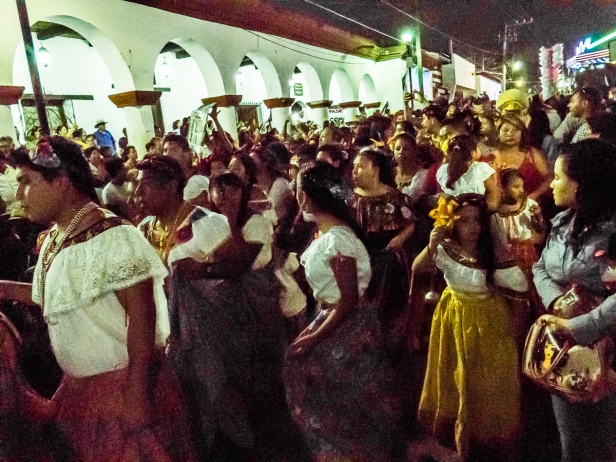

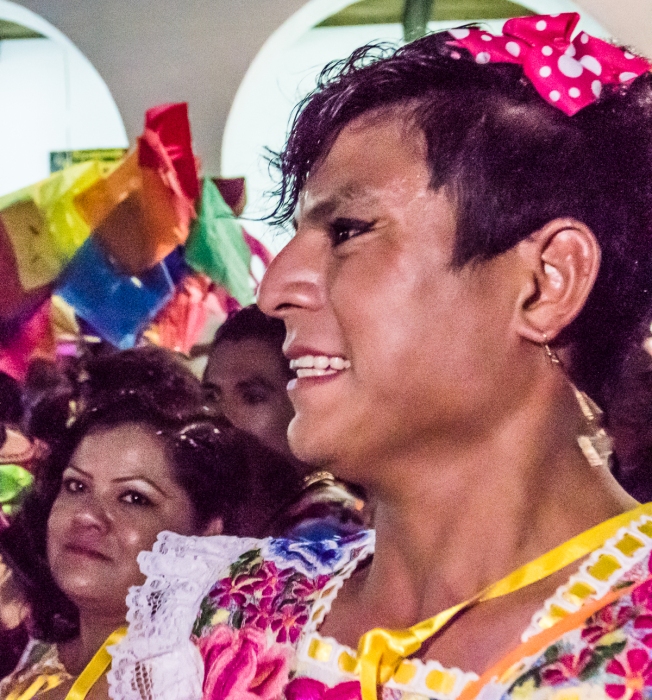

The mood is different – crazier, louder, more excited, more joyous. It’s a parade and it’s a wild party.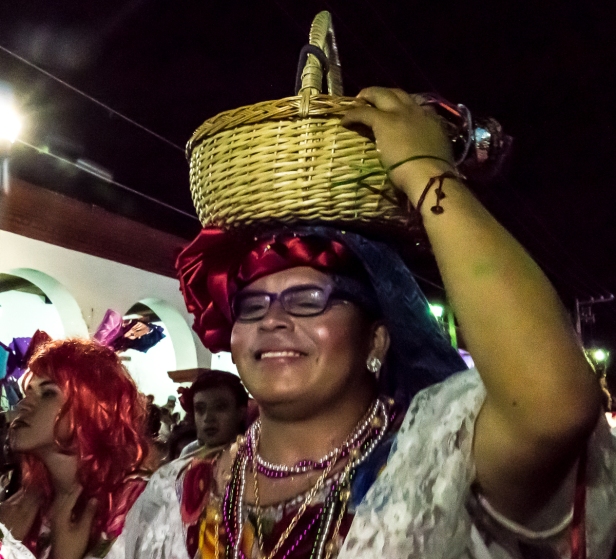

Suddenly I’m surrounded by four women from the parade and one of them thrusts a shot glass in my face. My first reaction is to refuse but it’s clear they will not take no for an answer. So I down it, whatever it is, and then take a handful of spicy peanuts from a bag offered to me by one of the other women. This is a fiesta! You don’t refuse a drink!
The glacier is wide and powerful and takes whatever room it needs. My feet are trampled, first one then the other; a flying rattle hits my camera. Often I have it clutched to my chest as I press back against the people who’ve squeezed in behind me. Suddenly one of the chuntas leans in and sweaty kisses me on the forehead.
And the next thing I know four Chuntas have pulled me right into the middle of the parade and are dancing around me. I dance too for a while then inch my way back to the curb and watch as the revelries continue.
I know there is much more to come but it is dark and I’m weary so I decide to go home. Somehow I manage to cross the glacier, but then come to another barricade of people at the entrance to the street where our hotel is. It’s about ten feet thick but I’ve had practice now. I push my way through and escape to the other side. Somehow, miraculously, I still have my camera, and all my limbs. Don is already back at the hotel, and I’m surprised to discover it’s only 7.30.
23 January 2017. On the eighth day: we rested. We went for a stroll by the river and ate seafood-filled avocado at a restaurant overlooking the water. Then rested some more. In the evening we returned to the town square to find some Parachicos and Chiapanecas still marching, but we didn’t follow them. That was so yesterday. And the day before, and the day before. We wandered into the church. All the pews had been removed; people were wandering about, collecting things to take home, saying their good byes. It was all winding down, and in the middle of this vast space two Chiapanecas plopped themselves down on the floor and shared phone photos.
24 January 2017. On the ninth day: after a lazy start we took a taxi to the nearby town of San Cristobal de las Casas.
The Fiesta Grande de Enero is held each year from January 8th to 23rd in Chiapa de Corzo, Chiapas, Mexico
Next post: San Cristobal de las Casas
All words and images by Alison Louise Armstrong unless otherwise noted
© Alison Louise Armstrong and Adventures in Wonderland – a pilgrimage of the heart, 2010-2017.

The river trip has such a calming effect that is palpable, in conjunction with the crushing excitement of the throngs of people at the fiesta. I gotta love the cross dressing, it adds such a quirky interesting added dimension. My favorite photo, though of the fiesta, is of the two women dressed in black and white.
Much more my speed, sans the crowds of people, is the river trip and the gorgeous Christmas tree cliffs edge. That is quite a beautiful sight.
How wonderful you got to experience both Alison.
Peta
LikeLiked by 2 people
Oh we sorely needed that river trip, just as a break from the ‘crushing excitement’ as you put it. And the Christmas tree! I’ve never seen anything like it.
I too loved the cross-dressing – done with a complete lack of inhibition. Actually the opposite – those guys were proud and having fun! Also some women dressed as Parachicos so it went both ways though of course with their masks on you couldn’t tell. I have no idea about the women dressed in black and white. I’ve not seen them mentioned anywhere in all the reading I did, but they do look beautiful.
It was an amazing festival. I’m so glad we went despite the crushing crowds, and lack of both information and sleep.
Alison
LikeLike
What an amazing experience. One you will never forget. I love these fiestas and your photos are excellent. You captured the spirit.
LikeLiked by 2 people
Thanks Darlene. Yes, it was an amazing experience. This is our third Latin American festival and they’ve all been spectacular. I’m glad I managed to share something of the spirit of this one.
Alison
LikeLike
OMG. I have got to make it to this festival some day. Your photos are stunning. I love the one of the little girl, posing. I’m not surprised you needed a rest on the 8th day!
LikeLiked by 2 people
Thanks so much Tracey. It’s a fabulous festival. I hope you get there one day – well worth it. The dates are the same every year. That little girl was so adorable. I tried to get a candid shot, but in the end the posed one was the best one. She was totally expecting to be photographed, as do all the participants.
Alison
LikeLike
I believe you passed into a fantasy world and took photos while you were there. Truly awesome! :))
LikeLiked by 2 people
Thanks Susan. I think it really was a fantasy world. Every day there was something new about the festival to discover. It’s the second Mexican festival we’ve been to, and the other, Guelaguetza, was also amazing.
Alison
LikeLiked by 1 person
Wow! Thanks for sharing this amazing experience … and your spectacular, vibrant photos!
LikeLiked by 2 people
Thanks Donna. What a time it was! And it amazes me I was even able to get photos. Sometimes I just stuck the camera in the air and hoped for the best.
Alison
LikeLike
It’s funny how we divide up, isn’t it? I could barely focus on the party after the river trip. My heart was there with you, Alison. Sans crocodile, for preference, though those plastics were a surprise. Oh, but I did notice the little princess in the frock 🙂 🙂
LikeLiked by 2 people
That river trip was lovely though I do wish we could have lingered a little longer. But the plastic bottles – I was sad to see that. I loved the little princess. She was so solemn and conscientious. And of course her dress is gorgeous!
Alison
LikeLiked by 1 person
Allison, what joy the fiesta exudes! I’m not sure how I would have reacted to the drink handed to me by a total stranger in the midst of the revelry, but I think I would have somehow (as politely as possible) refused. The picture of the little girl stole the show. Fabulous pictures as always. – JJ
LikeLiked by 2 people
Thanks Joanne. I actually did refuse the drink, a couple of times, but they wouldn’t listen, and just kept insisting I drink it. Finally I thought Oh what the heck, and downed it. That little girl is such a delight!
Alison
LikeLike
Oh my god! What a fabulous spectacle the parade is! You are a trooper, and got fantastic photos…even after the shot of clear liquid you downed!!! Oh, the face of the deer woman is beautiful.
LikeLiked by 2 people
Thanks Angeline. It *was* a fabulous spectacle, and just about the whole town was involved one way or the other. It was one huge spectacular party. I have no idea what I drank except it definitely was alcoholic. I suppose I could have gotten a better shot of the deer woman if I’d asked her to pose – she was really beautiful.
Alison
LikeLike
So amazing! Fantastic post!!
LikeLiked by 2 people
Thank you so much. I’m glad you enjoyed it. It was a pretty amazing festival that’s for sure!
Alison
LikeLiked by 1 person
🙂
LikeLiked by 1 person
Such color and passion! The energy is clear through your words and photos. Love the contrast of the procession with your float on the river. Both subjects move forward with their own pace and identity.
LikeLiked by 2 people
Thanks Kelly. That was one full day. I’m so glad we got up early for the canyon tour. And then the rich craziness of the afternoon and evening! I love Latin American festivals. They’re always so full-on!
Alison
LikeLike
Shades of the Grand Canyon, Alison… without the rapids. 🙂 As for getting caught up in the glacier, it reminds me of the Mardi Gras in New Orleans. I’m a bit claustrophobic, so I do everything I can to avoid such situations. I remember well the feeling of not being in control, of having no option but to go with the crowd. I admire your fortitude in getting photos and a story! –Curt
LikeLiked by 2 people
Thanks Curt – I guess I was just really determined to get the story lol! But it was worth it – so much colour and joyous craziness. At least for a while. Ant then all of a sudden I was done and it was time to go home. Fortunately I’m not claustrophobic, because this crowd was one of the densest I’ve ever been in.
Alison
LikeLiked by 1 person
I’ve noticed your determination. 🙂 It’s a good thing, Alison.
LikeLiked by 1 person
Wow! Wow, wow, wow – I love your pics from Sumidero Canyon National Park. Absolutely gorgeous!
LikeLiked by 2 people
Thanks so much Felicity. The canyon trip was just what we needed to get a break from the madness of the festival.
Alison
LikeLike
I like your article, very inspiring and thank you for your post
LikeLiked by 2 people
Thank you very much. I’m glad you liked it.
Alison
LikeLike
What a colorful and lovely festival Alison. I love all those nature shots too.
LikeLiked by 2 people
Thanks Arlene. It was a wonderful festival – so colourful and joyous. And the canyon was beautiful.
Alison
LikeLiked by 1 person
Thanks too Alison.
LikeLiked by 1 person
Very vivid and colourful picture of the people… love it.
LikeLiked by 2 people
Thanks Nina. It was really amazing. I love their colours. And their passion!
Alison
LikeLike
Love the contrast of your river trip with the cliff side Christmas tree and soothing reflections in the water to the flat-out craziness of Chiapa de Corzo’s festival. I can almost feel the wild energy of the crowd, the music and crush of the people through your photos and descriptions! Anita
LikeLiked by 1 person
Thanks Anita. The river trip was lovely and much needed, and your description of the festival “flat-out craziness” is exactly right! So glad I was able to impart a bit of the atmosphere. It was wild!
Alison
LikeLike
It really is beautiful there!
LikeLiked by 2 people
Yes it is. We’re so glad we went. Beautiful scenery, and beautiful costumes. It was a good time.
Alison
LikeLiked by 1 person
Yes. I can see that from your pictures.
LikeLiked by 1 person
You have captured the color and fun of the festival with these amazing colection of photos. I felt that I was there celebrating on the streets. I hope to be able to see it myself one day 😄
LikeLiked by 1 person
Thanks so much Gilda. The best compliment I can get is that you felt you were there! I hope you get to see it one day. The dates are the same every year.
Alison
LikeLike
So glad you finally found the chuntas!! I think the wait was worth it, the images are just stunning!
LikeLiked by 2 people
Thanks Stephanie. Yeah, the wait was definitely worth it. I think it’s a great tradition, and so unique.
Alison
LikeLiked by 1 person
I always thought I was a misplaced Hispanic. They love to celebrate every aspect of life and so do I. Thanks for enabling me to experience such an amazing celebration!
LikeLiked by 2 people
Your photos of the canyon river and the Christmas tree are awesome. I could feel it.
LikeLiked by 2 people
Thanks Eileen. The river trip was lovely, and that “christmas tree” amazing. I’ve never seen anything like it. I too love the way Hispanic communities celebrate – so vibrant and passionate and colourful!
Alison
LikeLike
I really can’t imagine those crowds existing in the streets for two weeks; I think I might have escaped to the canyon and river more than once! I returned over and over to your exquisite photo of the tiny Chiapaneca – it’s a masterpiece, Alison!
LikeLiked by 2 people
Wow, thanks so much Lexie. I tried to get a candid shot of her but she saw cameras pointed at her and knew what she was supposed to do 🙂
The streets weren’t that crowded every day for two weeks, just at the parade times, but it was pretty crazy even so. We were down by the river quite a lot!
Alison
LikeLiked by 1 person
OMG Alison, I love that you are always introducing me to yet another fascinating part of Mexico. The Sumidero Canyon NP looks spectacular. I had not heard of it until now and it looks like we’d love it. Your festival photos are so colourful and mesmerizing. I keep looking at the deer and her boyfriend, wow!
LikeLiked by 2 people
Thanks Caroline. We found out by sheer good luck about the festival. I’m so glad we did. I love the Latin American festivals – they’re always so colourful and full-on. And the canyon and river was a bonus. I should think there’d be some good hiking in the NP for sure. The deer was quite spectacular. I wish I could have gotten a photo showing her entire outfit, but the head gear alone is pretty amazing.
Alison
LikeLike
beautifully alive canyon
and festive festivities!
i’m ready to go out
and enjoy whatever
festivities I find
outside 🙂
LikeLiked by 2 people
Have fun outside.
There are always festivities
to be found
with an open heart
even in canyons
or maybe especially
in canyons 🙂
Alison
LikeLike
Looks like an awesome festival! I’m loving the pictures! 🙂
LikeLiked by 2 people
Thanks so much. And yes, it’s an awesome festival!
Alison
LikeLike
I like you article, very inspiring and thank you for your post
LikeLiked by 1 person
Thank you very much. I’m glad you enjoyed it.
Alison
LikeLike
So the earth cracked, but where did all that water come from and keep coming from is what I want to know. Your photos just keep getting better and better. And in this piece, your writing is simply…a great and wonderful story! I hate crocodiles. Love the entire family of chuntas. And I’m wondering why the eyes on those masks are blue, not brown.
LikeLiked by 2 people
Thanks BF. I’m starting to feel more relaxed about writing, more trusting that it will just come. Also I’ve discovered if I describe something out loud to Don I reconnect with the feelings which helps. I’m not really a fan of crocodiles myself, but I’m always pleased to see them at a safe distance. I think there must have been some blue eyed Spanish somewhere along the line, or else it’s just artistic license. I still find photography both exciting and maddening, but do see a gradual improvement. Oh and the water? It comes from heaven 🙂
Alison
LikeLike
You know, you might want to tape record your discussions with Don. You’re a talker, and it might just help you write by listening to your own story.
And right…crocs at a distance are pretty cool.
Right…blue-eyed Spaniards…I’m sure that’s it.
LikeLiked by 1 person
I should do that. I talk about it all far more easily than writing about it. Sometimes the writing flows easily, sometimes it’s like pulling teeth, but I can always talk about it. Thanks for that.
I wonder if there ever have been any blue eyed Spaniards. I was surprised to meet a blue eyed Indian. I vaguely remember he said it was Persian heritage.
Alison
LikeLike
Oh, yeah, I’m sure there were. They are Europeans after all. Some have blonde hair. And the Inca dude on the cover of my Peru Lonely Planet guide has blue eyes!
LikeLiked by 1 person
That is one huge and impressive Christmas Tree, indeed! Unfortunately, in many developing countries like my own home plastic trash is a serious problem as we don’t have adequate facility for recycling (nor the culture to treat plastic waste differently). Sumidero Canyon National Park still looks so beautiful and magnificent nonetheless.
Alison, you’re not only so great at taking photos of cultural events, but also at immersing in those spectacles of colors, dance and music.
LikeLiked by 2 people
Thanks Bama. I do love to immerse myself if I can, at least a little bit. It’s fun to get the feel of it, and it was an amazing festival.
I was intrigued by the Christmas tree – I’ve never seen anything like it, and it’s so beautiful.
I know just what you mean about the plastic situation. It’s kinda heart-breaking. And it’s not only developing countries – I’ve certainly seen situations where people just don’t care which is even more heart-breaking 😦
Alison
LikeLike
Oh my goodness what a contrast! The serenity of the river and its jaw dropping scenery to the crush of the festival. Your words and photos had me feeling as if I was right there. I didn’t have a shot however. Just finished breakfast so a bit early. 🙂
LikeLiked by 2 people
Thanks Sue – happy to have you along 🙂
We so badly needed the contrast of that river trip. The festival was so full-on that we needed a break.
Alison
LikeLiked by 1 person
WOW factor…love these…the gaze of the people…the colour…i can feel the vibrant atmosphere…always appreciate the way you compose your posts…have a happy day ~ smiles hedy 😀
LikeLiked by 2 people
Thanks Hedy. The atmosphere was so wild and joyous, and so colourful. I’m glad I could capture that a bit. Happy day to you too 🙂
Alison
LikeLiked by 1 person
Thank you kindly Alison! ☺️
LikeLiked by 1 person
I like how you were worn out and went home only to find out it was 7:30pm. That is Mexico for you! Your description and photos remind me of what I love about Mexico so much – I don’t think anywhere in the world has such unbridled party with so much color.
That canyon looks spectacular too.
Glad you survived with your limbs and camera!
LikeLiked by 2 people
I agree about the colour! I love their complete lack of fear of colour. I’ve seen it also in South America. We went to a festival in Puno, Peru and it was just as wild.
If I hadn’t been so exhausted from already hours trying to find, and then following the parade I’d have stayed longer. Honestly I think I only saw a small part of it. The lack of light/inability to get decent photos was also a factor.
The canyon was lovely – not one of the most spectacular places in nature we’ve been (I’m thinking about your photos from AK and similar places I’ve been to) but it was a very welcome break from the madness of the festival.
Alison
LikeLike
When we were in Mexico last time we joked/fantasized about spending 1 year going to all the festivals in the country. That would be an awesome and tiring year!
Where are you headed next?
LikeLiked by 2 people
We are back in Vancouver to stay for a while. It’s time for a bit of a break.
LikeLike
it’s really amazing Chuntas and the Canyon……
LikeLiked by 2 people
Thank you so much. Yes, it really was amazing!
Alison
LikeLike
What amazingly colorful costume Alison but what I like the best are the men dressed up like women for the festival! Must have been a sight to see! Gorgeous photos and narrative as always!
LikeLiked by 2 people
Thanks so much Nicole. I loved seeing the Chuntas. I’ve been to a few festivals but I’ve never seen anything like that. And they were so proud and up-front about it. In no way did they feel that their masculinity was threatened, but rather there was a deep connection to, and pride in, the traditions of the community. And oh the colours! I don’t think a Latin American country exists where they are restrained in their use of colour!
Alison
LikeLiked by 1 person
Love this so much. I can’t believe also how long the celebration lasted. I wish our country would take note and do more fun festivals.
LikeLiked by 1 person
What an astonishing knowledge. One you will always remember. I cherish these celebrations and your photographs are superb. You caught the soul…
LikeLiked by 2 people
Thank you so much! It was so exciting to be there for this festival. India also has amazing festivals!
Alison
LikeLike
What an astonishing knowledge. One you will always remember. I adore these parties and your photographs are fabulous. You caught the soul…
LikeLiked by 2 people
Thanks so much for your kind words. I too adore these kinds of parties! So much fun.
Alison
LikeLike
How fabulous Alison!!! What a striking contrast between the serene boat ride and the energetic revelry. Love those costumes. Thank you for bringing this all alive for us in such vivid and colourful detail.
LikeLiked by 2 people
Thanks Madhu. It was an amazing festival – so vibrant and wild. We really needed the time on the river to calm down a bit!
Alison
LikeLike
What a fantastic experience! One I am sure you will not forget soon. The pictures are stunning, you truly captured the festivities perfectly.
LikeLiked by 2 people
Thanks so much! It *was* a fantastic experience! I’m so glad we went. Latin American festivals are always amazing.
Alison
LikeLike
Wow!!! I have really enjoyed being on this journey with you. What an experience!
LikeLiked by 2 people
Thanks Mo. I’m so glad you enjoyed it. It was an amazing time that’s for sure.
Alison
LikeLike
I was taken back to our time in Mexico, chasing parades, never-ending music and cojotes. What a gift to have time on the water, away from the masses. Love your photos!
LikeLiked by 2 people
Thanks LuAnn. Mexico is amazing for its festivals – so much colour and passion and joy. We loved it, but yes, the time on the water was much needed.
Alison
LikeLiked by 1 person
fantastic photogallery!
LikeLiked by 1 person
Thanks so much Stef.
Alison
LikeLike
You are hugely talented Alison. You write so compellingly, because you think well, and your photography is pure genius.
LikeLiked by 1 person
Wow, Cindy, thank you so much. What wonderful compliments! I think doing this blog (for over five years now!) has both helped and compelled me to become a better writer, and a better photographer. And I also have two sisters to thank for teaching me about photography.
Alison
LikeLike
Excellent photography fell in love seein the places..would like to visit it once.
LikeLiked by 1 person
Thanks so much. We’ve travelled through quite a bit of Mexico and I highly recommend it. It’s a fascinating culture.
Alison
LikeLiked by 1 person
So incredibly colorful. I love how Hispanic cultures are so vibrant.
LikeLiked by 1 person
Yes, me too! We’ve travelled through quite a lot of Latin America and it’s the same everywhere – amazing festivals, and a great love of bright colours. The vibrant energy is endlessly engaging.
Alison
LikeLiked by 1 person